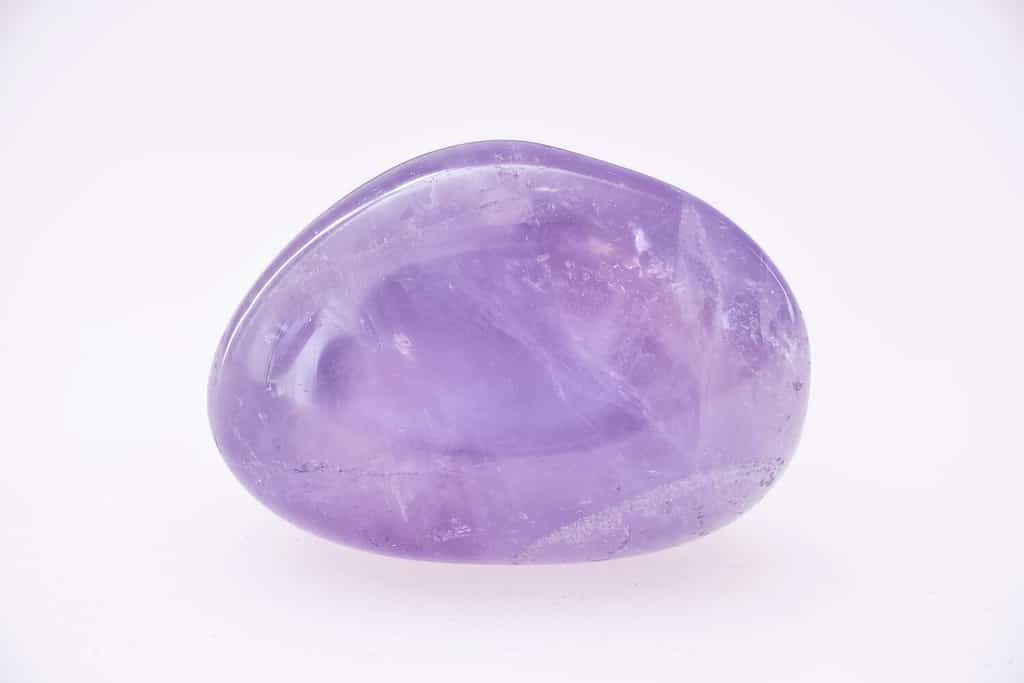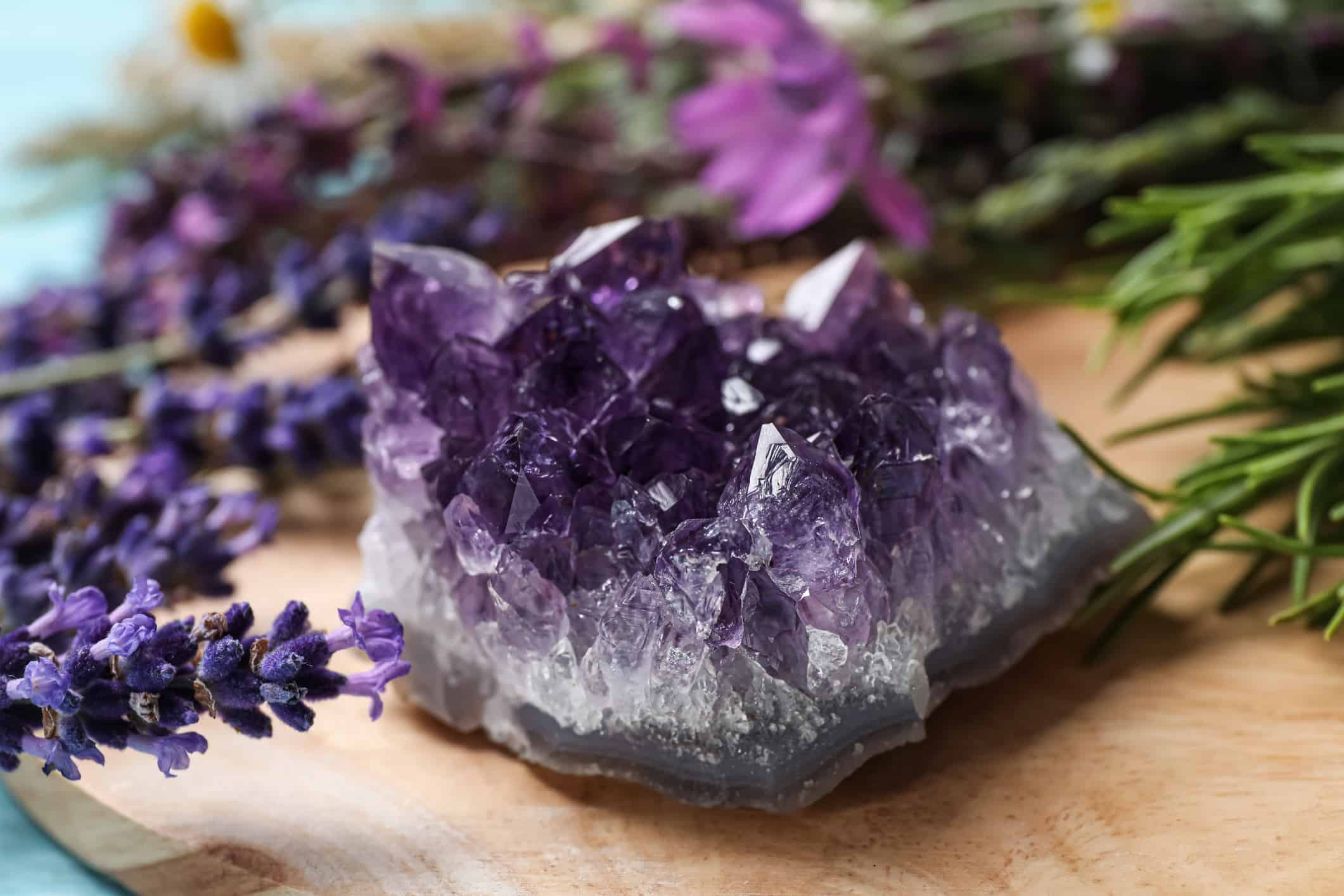Amethyst is a common type of quartz found all over the world. Its violet coloring makes the crystal extremely attractive in the jewelry market, and the spiritual community also swears by its grounding effects. Hailed as a healing crystal, amethyst is one of the most popular gemstones today. However, did you know amethyst takes millions of years to develop? That’s right — today’s natural amethyst dates back millions of years ago. Discover how this crystal is formed and its many uses, from healing to aesthetics.
What Causes Amethyst to Be Purple?
If you’ve ever seen amethyst, you know it radiates beautiful shades of purple. Amethyst’s violet coloring results from irradiation, iron impurities, and crystal lattice substitutions. In other words, radiation will oxidate the iron in the quartz and change its hues to a purplish color.
It is also said that silicon dioxide, or silica, contributes to the violet shades of amethyst. Silica is a naturally occurring compound made of silicon (Si) and oxygen (O2). It can be found in sand, as quartz like amethyst, in plants like rice, and in concrete.

Amethyst is a naturally-occurring quartz crystal that’s known for its beautiful violet coloring.
©mineral-vision/Shutterstock.com
How Long Does it Take for Natural Amethyst to Form?
Natural amethyst takes millions of years to form. The geodes we have today actually date back to prehistoric times. The crystal forms from the water and minerals within cavities of hollow, pyrogenic volcanic rocks. As lava cools over time, it crystalizes and forms amethyst.
In addition to hollow rocks, other key ingredients required to form amethyst include silica and ferric iron (found in water), as well as varying levels of carbon, calcium, and oxygen. However, the most important element of amethyst formation is millions of years of time.
Where Is Amethyst Naturally Found?
Most commonly, amethyst is naturally found in volcanic rock, hydrothermal veins, and sometimes in the cavities of sedimentary rocks. In the United States, you can find amethyst in Arizona, Texas, Pennsylvania, North Carolina, Maine, and Colorado.
Because of its popularity in the spiritual community and jewelry industry, you can purchase amethyst all over the country (and the world). However, if you’re purchasing amethyst, make sure it’s from a reliable source and isn’t a fake stone. Many sellers claim to offer all-natural amethyst but are really selling a cheap rendition of the crystal.
Where Does Amethyst Grow?
Like other quartz, amethyst grows in or around extrusive and intrusive igneous rocks, metamorphosed rocks, hydrothermal veins, and hot springs. Once hot thermal water cools, it crystallizes and can form amethyst. Again, it takes millions of years to form the crystal.
Currently, the most common place for amethyst deposits is Brazil. However, amethyst geodes are frequently found in and mined from volcanic rocks and hydrothermal veins across the world — mainly in South America, Africa, and North America.
Meaning of Amethyst
The word “amethyst” comes from the Greek word “amethystos,” which translates to “not intoxicating.” As a result, many people believe amethyst can help keep you sober and grounded. In fact, ancient Greeks apparently used amethyst to fashion drinking vessels to protect them from getting drunk.
Spiritually, amethyst represents calmness, peace, and balance. It’s also common for crystal practitioners to use amethyst for protection from negative energy. Today, many spiritual individuals will carry amethyst as a supernatural protection source. Some even sleep with it in their room or under their pillow to keep them from having nightmares.
Additionally, because the ancient Mediterranean associated the color purple with royalty, many people associate amethyst with wealth, power, and status. It was a highly treasured crystal for thousands of years, and it’s still valued as such today.

Amethyst is a healing, balancing crystal used by many natural health practitioners and spiritual gurus.
©William G Forbes/Shutterstock.com
Benefits of Amethyst
Here are some of the presumed benefits of amethyst.
Contains Healing Properties
While there’s not much scientific evidence that amethyst is a healing stone, many Ayurvedic and natural health practitioners swear by its power. According to such practitioners, the stone boosts the immune system, balances hormones, promotes better digestion, and gives the skin a natural glow.
Additionally, as stated above, amethyst embodies sobriety, and many use it to support recovery from addiction. Many also believe amethyst can reduce anxiety and treat a host of other mental health symptoms.
Opens the Third Eye
Many in the metaphysical community credit amethyst with opening the third eye. The third eye represents increased spiritual awareness, wisdom, and power. According to many practitioners, by wearing amethyst or placing it on your body for healing, you can more easily connect with higher consciousness and receive spiritual downloads.
Absorbs Negative Energy
Crystal practitioners often use amethyst to absorb negative energy, encouraging a calmer environment. They claim that simply placing amethyst within your home or wearing it as jewelry will protect you from negative entities. This allows you to keep your own vibrations high and energy positive, regardless of the energy around you.
Amethyst Uses
You can use amethyst in many ways, whether for aesthetic purposes or spiritual aid and protection.
Wear Amethyst as Jewelry
Because it’s a particularly durable gemstone, amethyst is perfect for jewelry-making. Its gorgeous purple color makes it a beautiful and highly adorned accessory. Many wear amethyst as a necklace, bracelet, earrings, rings, or another form of jewelry.
Place Amethyst Around Your Home
Natural healers say placing amethyst around your living space can clear negative energy. Many use it specifically to prevent nightmares when sleeping or to keep evil entities from entering their homes. This helps cultivate a calmer, more balanced environment for you to unwind.
Because it’s also an attractive crystal, you can use it as decor, too! Large, violet amethyst crystals make beautiful additions to bookshelves, nightstands, and even windowsills where they can catch the sun.
Carry Amethyst With You
Whether you’re tucking amethyst into your purse, keeping it in your car, or even attaching it to your keychain, you can bring this crystal with you for protection. As you venture out into the world, count on your amethyst to keep you grounded, balanced, and rational — regardless of whatever chaotic or toxic energy you might come into contact with. Since it comes in various forms, from large crystals to small stones, you can easily keep your amethyst hidden in your pocket or displayed on your dashboard, depending on your preference.
Hold Amethyst as You Meditate
Due to its grounding effects, holding amethyst as you meditate can help keep you centered and focused on your breathing. It can also encourage spiritual connection with higher consciousness as you get still and quiet with your own energy. Place the stone on your thighs, hold it in the palm of your hand, or place it on your body as you rest on your back, and let it do its magic!
Where to Buy Amethyst
You can purchase amethyst almost anywhere today, from local metaphysical shops and jewelry stores to online sellers and shops. However, it’s important you look for all-natural amethyst, as much of what you can find today is actually fake or overpriced. Natural, genuine amethyst is actually quite affordable, sold for as little as $2 per carat.
Many scammers sell fake amethyst by marketing it as an exotic variation of the crystal, but this isn’t necessary when selling real, naturally-occurring amethyst. Typically, you can tell if amethyst is fake by examining its coloring, clarity, and durability. It should have color zoning (meaning it isn’t just one shade of violet), appear relatively eye clear, and be particularly hard.
Thank you for reading! Have some feedback for us? Contact the AZ Animals editorial team.








